Testing a lead colorimetric assay
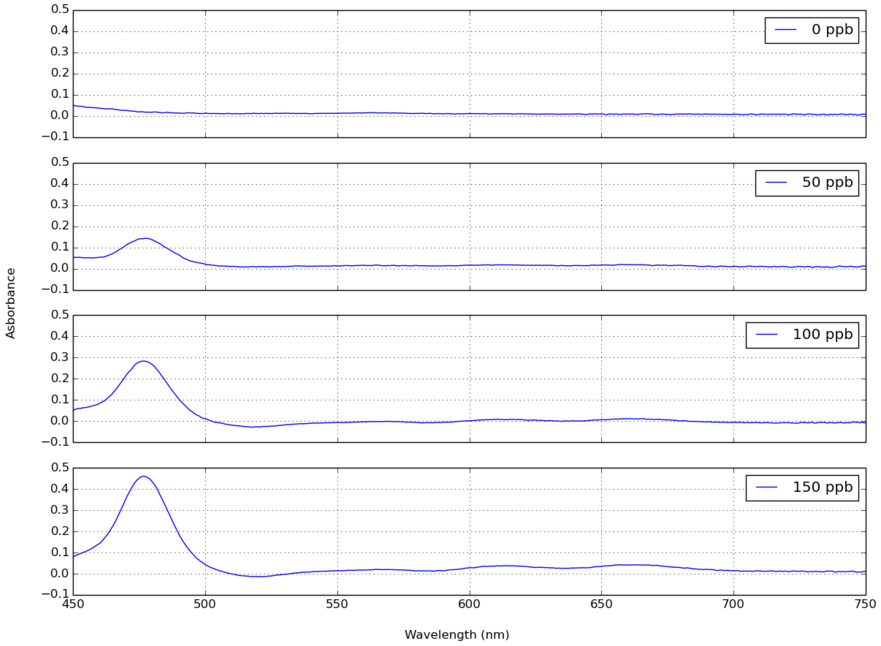
In this blog post we describe our initial testing of a colorimetric kit for measuring lead in drinking water. In 2015, a Virginia Tech research team found that over 40% of the homes in Flint, MI had elevated lead water levels with 25% of homes well above the EPA 15 ppb maximum contamination level. The levels of lead in drinking water should be zero or undetectable. The Flint water crisis was widely reported in the news and lead contamination of drinking water is still an ongoing public concern.
The goal of this project was to find an affordable and easy-to-use lead test for measuring lead in the low ppb range that could be used with our $80 open source colorimeter kit. The Hach LeadTrak Fast Column Extraction Method is a colorimetric assay that can measure from 5 ppb up to 150 ppb. Cost is approx. $12 per test. Below we describe some of our initial results with this lead test. We may examine other tests in the future.
Method
The method for using the kit is described here: LeadTrak Fast Column Extraction Method. Most of the steps were followed exactly as described. There is a modification to the procedure after Step # 13.
- Step # 13 - add the pPb-5 Indicator Powder Pillow and mix by swirling. The solution turns brown (same as instructions)
- Label two 12 mL tubes - "A" and "B"
- Transfer 10 mL of the solution to tube A and 10 mL to tube B
- Add 3 drops of decolorizer solution to tube B only and mix by shaking
Additional equipment used
- A stand and clamp for mounting the extraction columns
- Plastic beakers and cylinders: 2 x 250 mL beakers, 1 x 50 mL beaker, 1 x 100 mL cylinder, 1 x 50 mL cylinder, 2 x 12 mL sample tubes with caps
- Colorimeter or Spectrophotometer
- Disposable cuvettes
- Distilled or deionized water
Preparing a calibration curve
The first step was to prepare a 4-point calibration curve. The LeadTrak kit contains a 10 mg/L (10,000 ppb) standard. This was diluted with deionized water to make 100 mL of each calibration solution as shown in the Table below.
SAMPLE 10 mg/L lead Deionized Water
0 ppb 0.0 mL 100.0 mL
50 ppb 0.5 mL 99.5 mL
100 ppb 1.0 mL 99.0 mL
150 ppb 1.5 mL 98.5 mL
Samples were processed as described in the Methods. According to the Hach documentation, absorbance is measured at 477 nm so we used the 470 nm blue LED in the colorimeter as follows.
- Calibrate (blank/zero) the colorimeter using the solution in tube B. Absorbance measurement should read 0.0
- Measure absorbance of tube A at 470 nm. This is the solution without the decolorizer
- Record absorbance and prepare a calibration curve
Once we started testing we found that the absorbance values for the samples measured with the colorimeter were pretty low, with the highest 150 ppm sample only having an absorbance value of 0.21. So we also measured the absorbance of the samples with a spectrophotometer at 477 nm for comparison. We modified the colorimeter to use the Ocean Optics USB2000 spectrophotometer to produce the absorbance spectra shown below for all 4 calibration solutions.
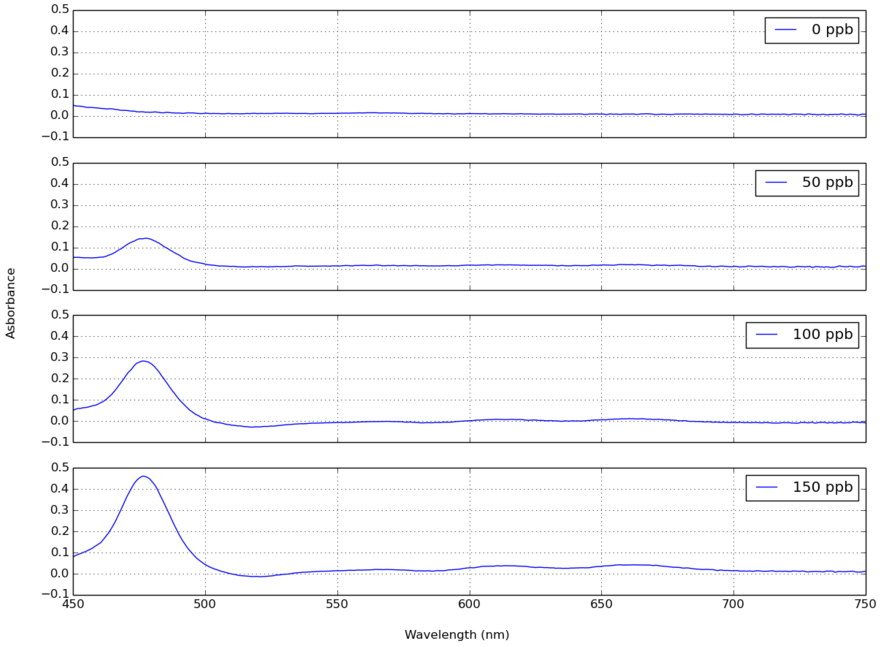
You can see the peak absorbance at 477 nm which corresponds to the lead concentration. We used this data along with the colorimeter data to make the calibration curves shown below.
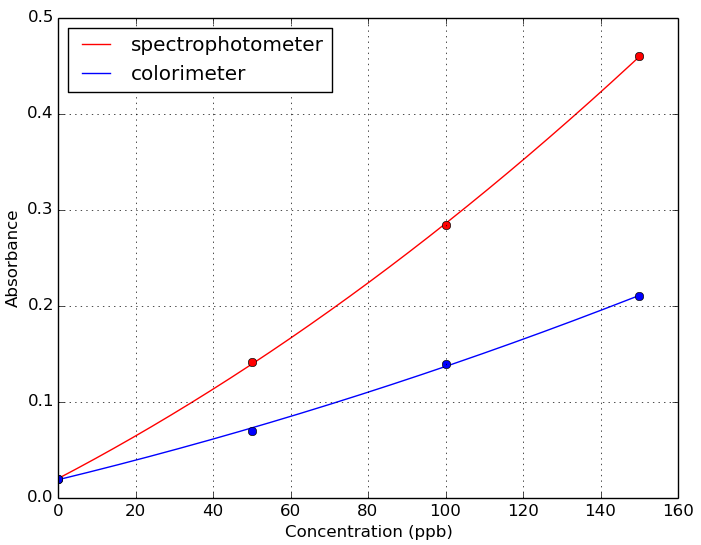
Measuring lead in tap water
The next step was to use this calibration curve to measure lead in our home water supply. We took samples as follows:
-
Tap water - Water from a regularly used kitchen water tap. Water was run for about 5 mins before a sample was drawn. Collected 100 mL.
-
Pipe sample - Water from a tap that had not been opened in at least 24 hours. Collected the first 100 mL. Should indicate any contamination of water from lead in pipes.
Samples were processed along with a 100 ppb calibration for comparison. Unfortunately using the Colorimeter 470 nm LED isn't going to be sensitive enough to measure values in the lower ppb range that we are interested in, so we only used the Spectrophotometer.
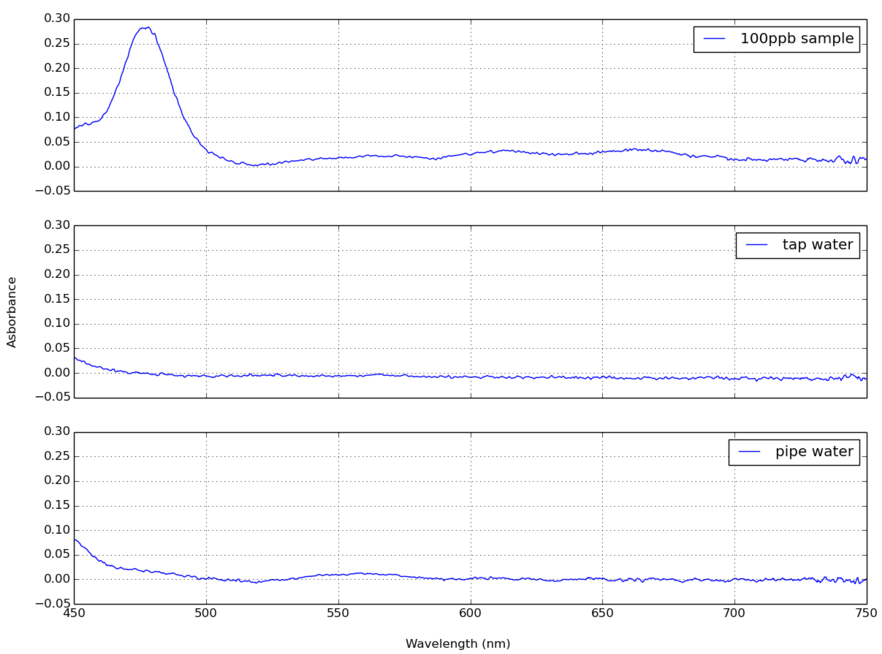
SAMPLE LEAD CONCENTRATION 100 ppb control 98.61 ppb Tap water sample Undetectable (less than 3 ppb) Pipe water sample Undetectable (less than 3 ppb)No lead was detectable in either water samples.
Summary
Overall we found that the Hach LeadTrak method for measuring lead in drinking water was very easy to use and gave very repeatable results. During several preliminary tests not shown here, we found that we were getting very consistent results for the calibration standards with both the colorimeter and the spectrophotometer. Although abit pricey ($12 per test) it is a convenient lead test and only takes 15 - 20 mins once you are familiar with the method.
Low range lead measurements (5-15 ppb)
For measuring low levels of lead in drinking water you should use a spectrophotometer and measure at 477 nm (+/- 2 nm). With this method we did not find any lead above 3 ppb in our water.
High range lead measurements (50-150 ppb)
For measuring higher ranges of lead you can use the colorimeter with the 470 nm blue LED. The unmodified colorimeter was not sensitive enough to detect lead in the range we are interested in (5-15 ppb range).
Next Up
The colorimeter can be modified by using a bandpass filter, so we will repeat the measurements with a 480 nm +/- 2 nm bandpass filter shortly. This will enable more sensitivity as we will be measuring closer to the absobance max. The filter costs an additional $35 but this would still be significantly lower than the cost of a spectrophotometer.

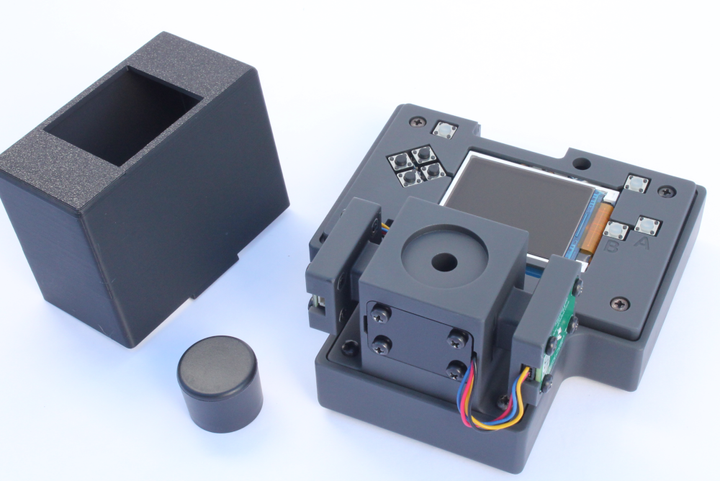
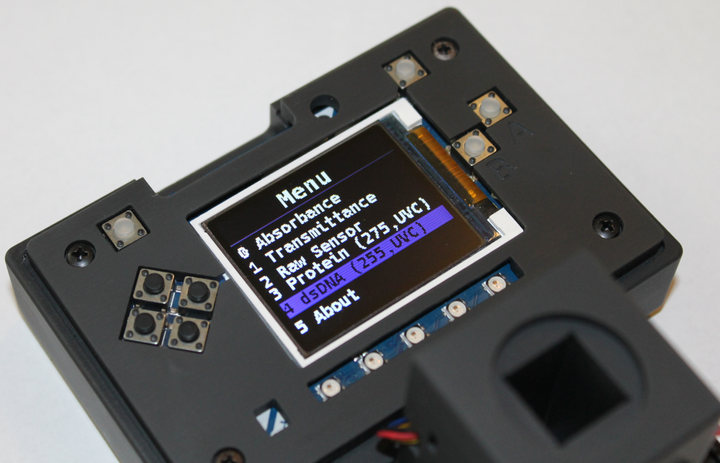
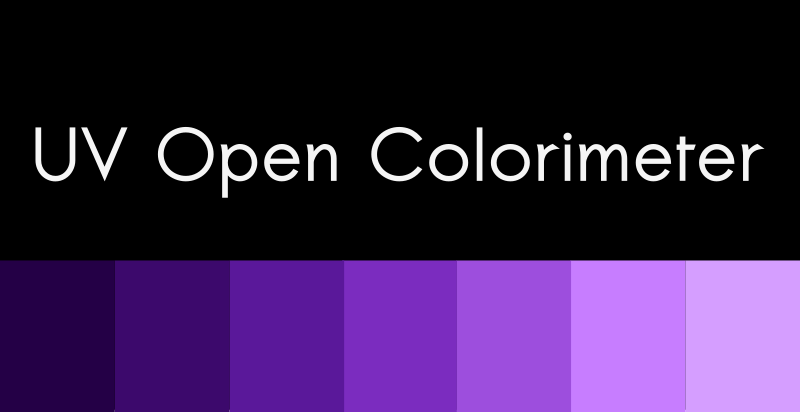
Comments ()